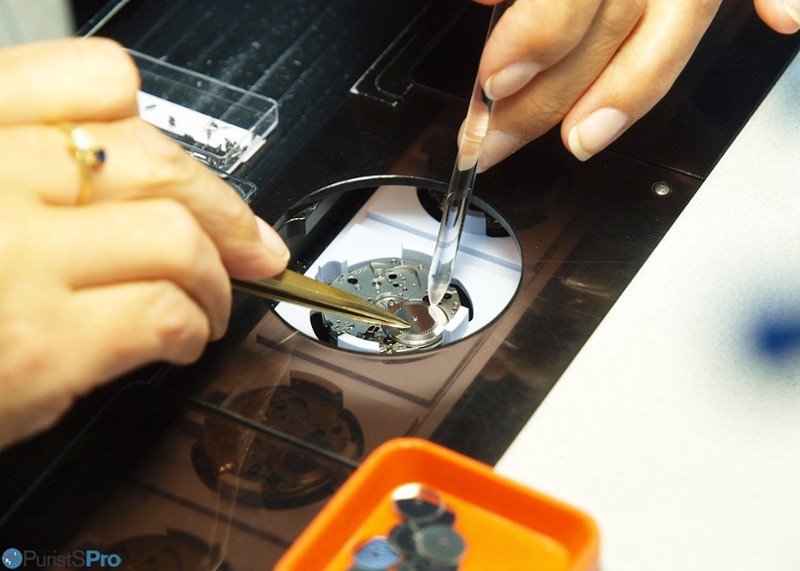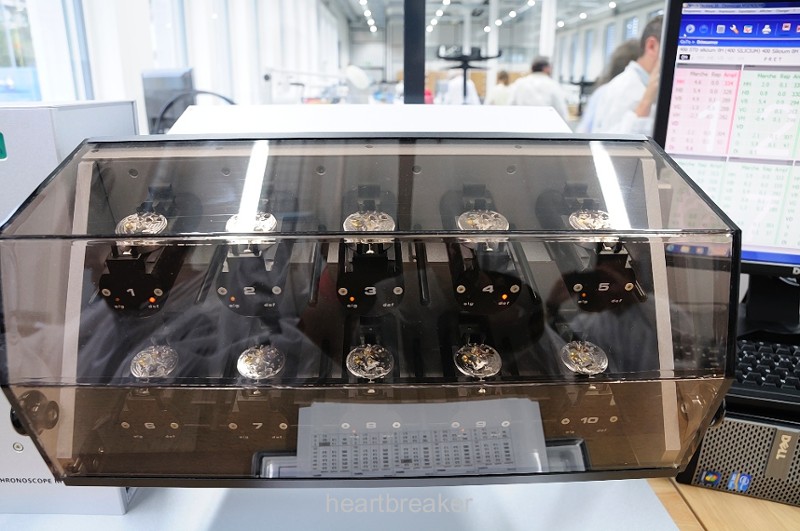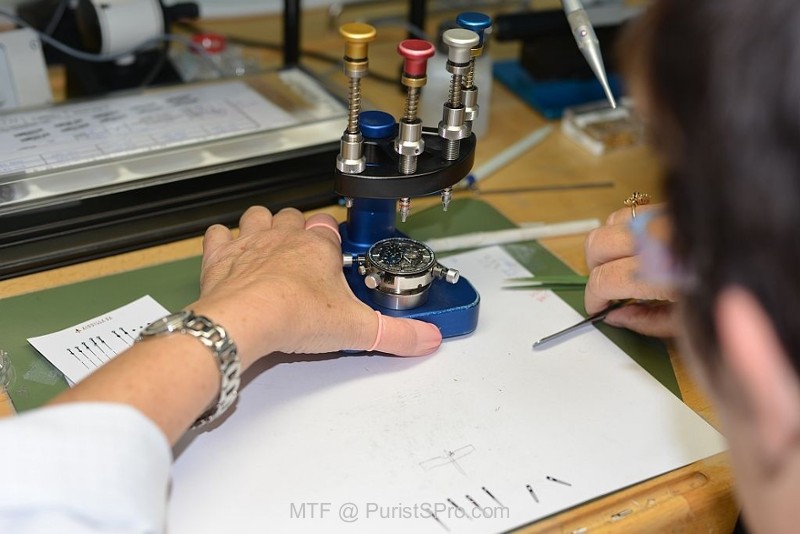
Ornatus-Mundi
[Zenith]
7136

PoT 2014 - PuristS members visit the Zenith Manufacture (ii/ii)
Some time back Elio and myself published the first instalment of the 2014 PuristS-on-Tour trip to Zenith, covering the ‘primary production’ at the fully integrated manufacture: click here !

With this final instalment we will guide you through those sacred departments who do the final assembly and regulation of all Zenith watches, and that are responsible for quality control (a process that is integrated alongside the entire assembly procedure).
At the end of the primary production steps , Zenith has the components of any watch of its collection available, movement blancs, cases, hands or rotors. Most of those are made in-house, whereas some come from outside specialist supplies such as cases, hands or dials (see our PoT report on the Fehr S.A. dial maker: click here (parts i & ii) and here (parts iii & iv)).


In order to minimise revisions, repairs and rejections right from start, all components, be they in-house or externally sourced, are rigorously tested by a specialist quality control department located in a dedicated workshop:


Inspections my involve checking of critical measurements against spec sheet data…


… and/or for optical perfection.


Only after successful completion of these inspections parts are cleared for assembly - with a personal signature on each satisfactory batch.

Assembly means very different steps. Of the very basic ones Zenith executes is the putting together of singular parts into functional units, a task executed in a separate atelier:


The image above shows an automatic ruby setting machine. The robot precisely sets rubies into their designated places of – in this case – a Zenith El Primero movement bridge.

Other units are put together by hand, such as these chronograph levers. To the left you see raw levers; to the right you’ll notice two pins which have been friction fit.

This is result of concentrated handwork using precision jigs.

Having completed the critical evaluation, all preassembled components of a movement are now ready to be completed into a fully working El Primero movement:

How subsequent assembly steps are implemented depends highly on the complication grade of the final watch. Consistent with the difference in finishing, assembly is also divided: whereas the haute horlogerie pieces, i.e. the Academy watches, tourbillons and the like, are individually completed by highly qualified watchmakers, the less complicated watches are finished in an assembly line arrangement.
We will visit the latter atelier first. As you can see, PuristS spent a bit too much time with the other departments, thus quite a lot of the workforce was already on its way home when we finally arrived here ;-). Nevertheless, still sufficient people to tell the story!

The most interesting object here is the advanced technology that is integrated into the ‘etablis’: cassettes holding batches of movement plates are fed into a receptor. Movements are automatically retrieved and placed on a band at the front of the desk. A translucent glass covers the line, protecting the blanks from dust but allowing the technician to inspect what is happening there.

At the ‘work station’ an opening allows access to a single movement.

If needed the movement can be lifted up to facilitate access.

After the watchmaker completed the respective step, the movement travels further and is finally placed into its designated seat in a cassette. Once the cassette is full, it can be taken and handed over to the next work place. This way assembly is made more efficient, safe (protection of movement) and clean (protection from dust).

In the atelier for complicated watches the atmosphere is entirely different.

Producing masterpieces like those…

… is much more demanding and requires a lot of skill and expertise – quite obviously:

Concentration and dedication transpires, to the extent that we were not noticed at all – by some:

What is striking is the additional amount of handwork and traditional tools which characterises the workflow here. At the end, an almost finished movement is created, still without rotor - as this part impedes with ease of regulation:

What follows now is the last step to be executed on the movement directly - its regulation:


Completed movements are checked for accuracy and precision in batches. The performance of each movement can be measured and recorded individually.

A Zenith watch finally takes shape!

Now, with the movement finished, its high time to add some spice – here in form of the dials…

… and the hands. Now, hands are not just pointers. They have inserts, complex shapes; amongst them their inclination towards the outer rim of the dials in order to facilitate reading of time.
This inclination is not applied at the hand maker’s. In fact, this is done manually at Zenith. We were treated with a demonstration:

Here we see a craftswoman carefully rolling a rod over the tip of a hand. As the surface she uses is rather soft, the hand bends upwards, resulting the in the slight inclination:


Now, the hands are mounted on the movement using staking tools, each one for a different han:

Finally, our movement is ready for its marriage to case and dial:

The very last step now involves the mounting of the rotor…


.. and encasing of the watch!


You'll notice that PuristS tend to get more nervous alongside completion status of the watch...

Almost finished: encasing and closing of the case back:

And there is a result!

But Zenith is not content with this state. Two very crucial examinations are to be passed: As a fully integrated chronograph manufacture the company takes pride its El Primero movement, and thus it comes with little surprise that particularly the chronograph is tested thoroughly – in its case. This is of crucial importance since here movement, case and pushers act together, requiring a control after final assembly.

For this, Zenith has devised a special machine programmed such that a typical usage scenario is simulated (see above):

Second, Zenith requires, like other manufactures, a pressure test to assure water resistance:

Only after passing these tests, Zenith watches are declared completed, and straps are mounted:

After a final inspection, the watches are sealed in gum wrap and assigned a lot number for further tracking (effectively, being recognised as a Zenith entity):

Straps are attached…

The newborn Zenith watch is now ready to be shipped. A new owner, a new love, but certainly tremendous new pleasure!
For us PuristS the tour, technically, has come to its end. It was a great honour to be taken that deeply into the innards of one of the most respected and acknowledged manufactures. Proudly we put down our names in the Golden Book of the brand:


So, with two last images which perfectly exemplify how presence and past a equally cultivated at Zenith, we leave with lots of new impressions, and fascination.


No, another treat for us, in fact, many… See next post!

This message has been edited by Ornatus-Mundi on 2015-03-16 01:09:52
More posts:

PoT 2014 - PuristS members visit the Zenith Manufacture (ii/ii)
Some time back Elio and myself published the first instalment of the 2014 PuristS-on-Tour trip to Zenith, covering the ‘primary production’ at the fully integrated manufacture: click here ! With this final instalment we will guide you through those sacred...

Zenith got us PuristS *certified*, and made us drool one last time ;-)
Refreshments were offered (and well needed) after this exhaustive and intense visit. The real surprise for us await us after refreshments in the Zenith lounge downstairs: Zenith's Director of Hospitality, Mr Paul Wirth, got us certified : And this is the ...

Culinary delights and a "PuristS must-do"...
Now, it was almost evening: our mind already started spinning like the "Gravity Control" gyroscopic module and our hearts sped up beating like the "El Primero". Yes, the enthusiasm and the authentic gratitude for the Manufacture were absolutely at the top...
Excellent post. Thought I noticed a little something
in your sixth picture down. The tool that woman was using looked familar: It's not a tool people are used to seeing. I have never seen one on PuristS before, and I have one :) She was using a Cary comparator micrometer, a specialized quick-lever set micro...

Fascinating information - what do you conclude about this?
Is it that other companies do not apply the same intensity/coverage in parts control, or do you think the tool is used to be mobile and apply controls where needed (it appears to me quite flexible). Thanks, Magnus
Flexibility would be my guess.
Zenith's QC department looks extremely well equipped, and serious about what they are doing. I could say the same about many large companies though. But this is a good thing. There are far more exotic ways of measuring parts- CMMs and optical profilers co...

Thanks again - "great for checking values quickly from a standard size"
that appears to be exactly the use at Zenith. Thanks for enlightening us on this matter! Best, Magnus P.S.: More pictures or rare tools - sure, if I find (and identify) them!

Thanks for the report on the Zenith Tour
Great photos, looks like everyone had great time. Did you take home a Zenith watch as a souvenir from the trip? Regards, ED-209

Sure why not? :)
A new watch now as a souvenir to commemorate the trip, and as a placeholder for the special one for the 150th! :) Regards, ED-209

To visit a manufacture is such a great experience! :)
Never been to Zenith, but would love to go one day.... Thank you for these great reports, Magnus! :) Best Blomman